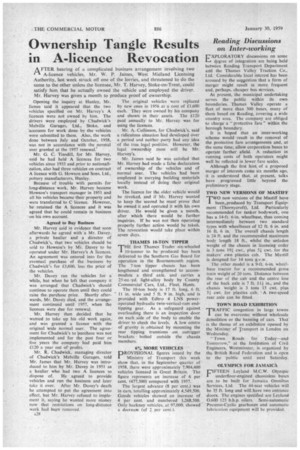Ownership Tangle Results in A-licence Revocation
Page 30

If you've noticed an error in this article please click here to report it so we can fix it.
A FTER hearing of a complicated business arrangement involving two 4-k A-licence vehicles, Mr. W. P. James, West Midland Licensing Authority, last week struck off one of the lorries, and threatened to do the same to the other unless the licensee, Mr. T. Harvey, Stoke-on-Trent, could satisfy him that he actually owned the vehicle and employed the driver. Mr. Harvey was given a month to produce proof of ownership.
Opening the inquiry at Hanley, Mr. James said it appeared that the two vehicles specified on Mr. Harvey's A licences were not owned by him. The drivers were employed by Chadwick's Melville Garages, Ltd., Stoke, and accounts for work done by the vehicles were submitted to them. Also. the work done between July and October, 1958, was not in accordance with the normal user granted at the 1957 renewal.* Mr. G. C. Tinsdill, for Mr. Harvey, said he had held A licences for two vehicles since 1933 and prior to nationalization. also had three vehicles on contract A licence with G. Howson and SOD% Ltd.. pottery manufacturers, Hanley.
Because of trouble with permits for long-distance work, Mr. Harvey became Howson's transport manager in 1951 and all his vehicles became their property and were transferred to C licence. However, he retained the A licences and it was agreed that he could remain in business on his own account.
Agreed to Buy Business
Mr. Harvey said in evidence that soon afterwards he agreed with a Mr. Davey. a private haulier and a director of Chadwick's, that two vehicles should be sold to Howson's by Mr. Davey to be operated under Mr. Harvey's A licences. An agreement was entered into for the eventual purchase of the business by Chadwick's for £3,600, less the price of the vehicles.
Mr. Davey ran the vehicles for a while, but when he left that company it was arranged that Chadwick's should continue to operate them until they could raise the purchase price, Shortly afterwards, Mr. Davey died, and the arrangement continued until 1957, when the licences were due for renewal.
Mr. Harvey then decided that he wanted to take up his old work again, and was granted a licence with the original wide normal user. The agree-• ment for Chadwick's to 'purchase was not implemented and for the past four or five years the company had paid him £120 a year out ofprofits.
Mr. R. Chadwick. managing director of Chadwick's Melville Garages, told Mr. James that Mr. Harvey was introduced to him by Mr. Davey in 1951 as a haulier who had two A licences to dispose of. He agreed to provide vehicles and run the business and later take it over. After Mr. Davey's death he attempted to put the agreement into effect, but Mr. Harvey refused to implement it, saying he wanted more money now that restrictions on long-distance work had been removed, A 28
The original vehicles were replaced by new ones in 1956 at a cost of £1,600 each. They were owned by his company and shown in their assets. The £120 paid annually to Mr. Harvey was for using the licences.
Mr. A. Collinson, for Chadwick's, said a ridiculous situation had developed over a period and neither party had any idea of the true legal position. However, the legal ownership must still be Mr. Harvey's.
Mr. James said he was satisfied that Mr. Harvey had made a false declaration of ownership of the vehicles and of normal user. The vehicles had been employed in carrying building materials locally instead of doing their original work.
The licence for the older vehicle would be revoked, and if Mr. Harvey wanted to keep the second he must prove that he owned it and operated it with his own driver. He would be given a month, after which there would be further inquiries. If he was not then operating properly further action would be taken. The revocation would take place within seven days.
THAMES 10-TON TIPPER THE first Thames Trader six-wheeled 10-tonner to be produced has been delivered to the Southern Gas Board for operation in the Bournemouth region. The 7-ton tipper chassis has been lengthened and strengthened to accommodate a third axle, and carries a 25-cu.-yd. light-alloy body by County Commercial Cars, Ltd„ Fleet, Hants. The 10-ton body is 17 ft. long. 6 ft. 11 in. wide and 5 ft. 9 in. high, and is provided with Edbro 4 LNS poweroperated hydraulic twin-vertical-ram endtipping gear. As a safeguard against overloading there is an inspection door on each side of the body to enable the driver to check the levels. A low centre of gravity is obtained by mounting the rear tipping trunnions on outrigger brackets bolted outside the chassis members.
6% MORE VEHICLES
PROVISIONAL figures issued by the Ministry or Transport this week show that, in the September quarter of 1958, there were approximately 7,904,400 vehicles licensed in Great Britain. The figure represents an increase of 6 per cent. (477.300) compared with 1957.
The largest advance (8 per cent.) was in cars, totalling approximately 4,549,500. Goods vehicles showed an increase of 4 per cent. and numbered 1,268,500. Only hackney vehicles, at 97,000, showed a decveast., (of 2 per cent.).




























































































